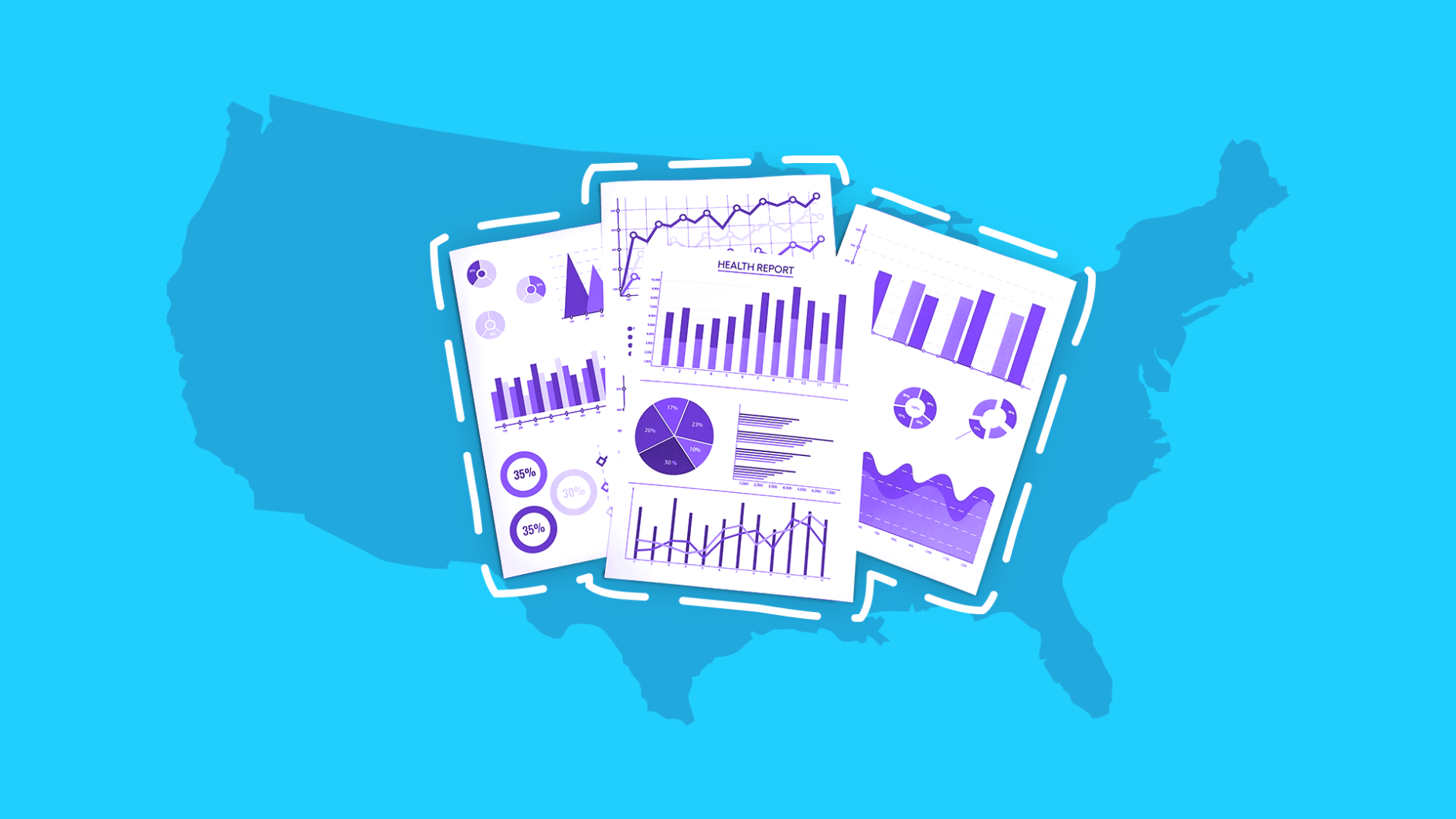Diabetes mellitus is one of the most common chronic diseases in America, according to the Centers for Disease Control and Prevention (CDC), and the prevalence of diabetes is increasing. In 2018, 34.2 million people had diabetes. That’s 10.5% of the U.S. population. The cost of diabetes is also increasing. The estimated medical costs per person with diabetes increased from $8,417 in 2012 to $9,601 in 2017.
SingleCare surveyed 500 people with diabetes to learn more about the condition, its treatment options, and its effects on American’s lives and wallets.
RELATED: Diabetes statistics
Summary of findings:
- 1 in 5 respondents reported that their symptoms lower their overall quality of life.
- Younger respondents are reportedly more negatively affected by diabetes than older respondents.
- Nearly two-thirds of respondents are reportedly concerned that their condition is a risk factor for contracting COVID-19.
- The most common type of diabetes medication among survey takers are biguanides such as metformin.
- Long-acting insulin is the most common type of insulin among our survey takers.
- Frequent urination, fatigue, and GI symptoms are reportedly the most common side effects of diabetes medications or insulin.
- 54% of respondents pay out of pocket for diabetes care.
1 in 5 respondents reported that their symptoms lower their overall quality of life
As a chronic illness, it’s not surprising that diabetes affects everyday life for most diabetes patients. Diabetes treatment typically requires healthy lifestyle changes and daily medication, and 74% of survey takers reported having an additional mental and/or physical health problem (comorbidity).
- 48% reportedly eat healthier.
- 25% of those who reportedly eat healthier also reported not having any diabetes complications or comorbid conditions.
- 30% reportedly exercise more.
- 24% of those who reportedly exercise more also reported not having any diabetes complications or comorbid conditions.
- 30% reportedly have less energy to do daily tasks.
- 29% reportedly worry about their condition and/or possible complications of diabetes.
- 34% of these respondents also experience GI side effects (upset stomach, gas, diarrhea, nausea, vomiting), and 57% also reported having hypertension.
- 19% reported their symptoms lower their quality of life.
- Of these respondents, 13% also reported weight loss, 21% reported yeast infections, 20% reported low blood pressure, and 32% reported shortness of breath as side effects of diabetes medications.
- Of these respondents, 16% also reported having kidney disease and 15% also reported having nonalcoholic fatty liver disease.
- 18% is reportedly depressed about their condition.
- 17% reported their condition does not impact their everyday life.
- More than half (55%) of these respondents also reported not taking diabetes medication or insulin.
- Half (51%) of these respondents also reported not experiencing any diabetes complications or comorbid conditions.
- 16% reported their condition hinders their self-confidence.
- Of these respondents, 45% also reported having hypertension, 17% also reported having hyperlipidemia or dyslipidemia, 18% also reported having kidney disease, 20% reported having nonalcoholic fatty liver disease, 16% also reported having a foot ulcer, 15% also reported having a history of diabetic ketoacidosis.
- 15% reported their diabetes care regimen has allowed them to live an overall healthier life.
- Nearly a quarter (21%) of those who reportedly live an overall healthier life also reported not having any diabetes complications or comorbid conditions.
- 13% reportedly worry about how they’ll afford their diabetes medication and supplies.
- 8% reported their condition has negatively affected their school or workplace performance.
- 8% reported their condition has negatively affected their relationships.
- These respondents also reported having the most diabetes complications or comorbid conditions. Of these respondents, 19% also reported having a heart attack, 60% also reported having hypertension, 60% also reported being overweight or obese, 24% also reported having cardiovascular disease, 24% also reported having kidney disease, 52% also reported having vision loss, and 29% also reported having a foot ulcer.
- 1% reported other ways their condition impacts their everyday life.
RELATED: Normal blood sugar levels
Younger respondents are reportedly more negatively affected by diabetes than older respondents
Twenty-five to 34-year-old respondents most commonly reported negative impacts of prediabetes/diabetes on everyday life.
- 31% of this age group reported their symptoms have lowered their quality of life.
- 28% of this age group reported their condition hinders their self-confidence.
- 28% of this age group is reportedly depressed about their condition.
- 27% of this age group reportedly worry about their condition and/or its possible complications.
- 21% of this age group reported their condition has negatively affected their relationships.
- 15% of this age group reported their condition has negatively affected their school/workplace performance.
On the other hand, respondents aged 55 and older are reportedly the least affected by their condition.
- 52% of respondents aged 55 to 64 and 51% aged 65 and older reported that they eat healthier.
- 26% of respondents aged 55 to 64 and 23% aged 65 and older reported that their condition does not impact their everyday life.
- 19% of respondents aged 65 and older reported that their diabetes care regimen has allowed them to live an overall healthier life.
Nearly two-thirds of respondents are reportedly concerned that they’re at a higher risk of contracting COVID-19 due to diabetes
Of the respondents who are reportedly concerned, 76% of them had Type 1 diabetes. This is interesting because people with Type 2 diabetes appear to be at a higher risk of severe illness from the coronavirus than those with Type 1, according to the CDC.
- 62% are concerned
- 38% are not concerned
The most common type of diabetes medication among survey takers are biguanides such as metformin
| Percentage of survey takers | Drug class | Examples of medications within drug class |
| 36% | Biguanides | Riomet, Fortamet, Glumetza, Glucophage (metformin) |
| 19% | Insulin | |
| 10% | Sulfonylureas | Amaryl, DiaBeta, Diabinese, Glucotrol (glipizide), Glycron, Glynase, Micronase, Tol-Tab, Tolinase |
| 9% | Incretin mimetics (GLP-1 agonists) | Adlyxin, Bydureon, Byetta,, Trulicity, Victoza, Ozempic |
| 7% | Gliptins (DPP-4 inhibitors) | Januvia, Galvus, Onglyza, Tradjenta, Nesina |
| 6% | Gliflozins (SGLT-2 inhibitors) | Steglatro, Farxiga, Invokana, Jardiance |
| 5% | Thiazolidinediones (TZDs) | Avandia, Actos |
| 4% | Combination medication | Invokamet, Janumet, Synjardy |
| 3% | Alpha-glucosidase inhibitors (AGIs) | Glyset, Precose |
| 3% | Amylin analogues | Symlin |
| 3% | Meglitinides | Prandin, Starlix |
Additionally, 5% of respondents are taking other medications not listed above, and 31% do not take diabetes medications at all.
Long-acting insulin is the most common type of insulin among our survey takers
| Percentage of survey takers | Type of insulin | Examples of brand-name insulins |
| 14% | Long-acting insulin | Toujeo, Lantus, Levemir, Tresiba, Basaglar |
| 8% | Short-acting insulin | Humulin R, Humulin R U-500, Novolin R, Novolin ReliOn R |
| 8% | Rapid-acting insulin | Novolog, Fiasp, Apidra, Humalog U-100, Humalog U-200, Admelog |
| 7% | Mixed insulin | Humalog 50/50, Humalog 75/25, Novolog 70/30, Humulin 70/30, Novolin 70/30 |
| 6% | Intermediate-acting insulin | Humulin N, Novolin N, Novolin ReliOn N |
| 4% | Rapid-acting inhalation powder | Afrezza |
| 4% | Combination insulin | Xultophy, Soliqua |
Additionally, 2% of survey respondents are taking other insulin not listed above.
RELATED: Metformin side effects
Frequent urination, fatigue, and GI symptoms are reportedly the most common side effects of diabetes medications or insulin
- 24% reported frequent urination.
- Frequent urination affects more male respondents (30%) than females (18%).
- Frequent urination affects more respondents aged 65 and older (31%) than other age groups.
- 24% reported fatigue.
- 21% reported GI side effects (upset stomach, gas, diarrhea, nausea, vomiting).
- GI side effects affect more female respondents (26%) than males (17%).
- GI side effects affect more respondents aged 45 to 54 (30%) than other age groups.
- 11% reported a loss of appetite.
- Loss of appetite affects more male respondents (14%) than females (8%).
- Loss of appetite affects more respondents aged 25 to 34 (19%) and 35 to 44 (15%) than other age groups.
- 11% reported weight loss.
- Weight loss affects more male respondents (14%) than females (8%).
- Weight loss affects more respondents aged 25 to 34 (19%) and 35 to 44 (15%) than other age groups.
- 24% of respondents who reported their diabetes care regimen has allowed them to live an overall healthier life and 18% who reported they exercise more also reported weight loss as a side effect.
- 11% reported shortness of breath.
- Shortness of breath affects more respondents aged 65 and older (12%) than other age groups.
- 10% reported dark urine.
- 8% reported yeast infections.
- Yeast infections affect more female respondents (10%) than males (6%).
- Yeast infections affect more respondents aged 25 to 34 (15%) than other age groups.
- 8% reported low blood pressure.
- Low blood pressure affects more respondents aged 25 to 34 (15%) and 35 to 44 (15%) than other age groups.
- 8% reported other side effects (weight gain and joint and bone pain) or no side effects at all.
- 6% reported severe swelling.
- Severe swelling affects more respondents aged 55 to 64 (3%) than other age groups.
- 1% reported lactic acidosis.
- 31% reported they do not take diabetes medication or insulin.
Reported side effects of diabetes medications versus insulin differ
Of those taking medication:
- 34% reported GI side effects
- 35% reported frequent urination
- 32% reported fatigue
- 15% reported shortness of breath
- 8% reported yeast infections
- 5% reported low blood pressure
Of those taking insulin:
- 41% reported GI side effects
- 27% reported loss of appetite
- 18% reported dark urine
54% of respondents pay out of pocket for diabetes care
According to the American Diabetes Association (ADA), 67.3% of diabetes-related medical care (blood glucose tests, medication, supplies, visits to healthcare providers, etc.) is covered by Medicare, Medicaid, or the military; 30.7% is covered by private insurance; and only 2% of costs are paid by the uninsured. Our survey results told a similar story.
- 26% reported that insurance covers all of their diabetes care
- 20% reported that Medicare or Medicaid covers all of their diabetes care
- 16% reported that insurance partially covers their diabetes care
- 10% reported that Medicare or Medicaid partially covers their diabetes care
- 4% reported that they pay out of pocket with a prescription discount card (SingleCare, GoodRx, RxSaver, etc.) for their diabetes care
- 3% reported that they pay out of pocket for all of their diabetes care
- 21% reported that they don’t have any diabetes care
RELATED: How much does insulin cost?
Our methodology:
SingleCare conducted this diabetes survey online through AYTM on Oct. 3, 2020. This survey data includes 500 U.S. adults ages 18+ who reportedly have or have had diabetes. Gender was split 50/50.











